
Abensberg is a town in the Lower Bavarian district of Kelheim, in Bavaria, Germany, lying around 30 km (19 mi) southwest of Regensburg, 40 km (25 mi) east of Ingolstadt, 50 km (31 mi) northwest of Landshut and 100 km (62 mi) north of Munich. It is situated on the river Abens, a tributary of the Danube.
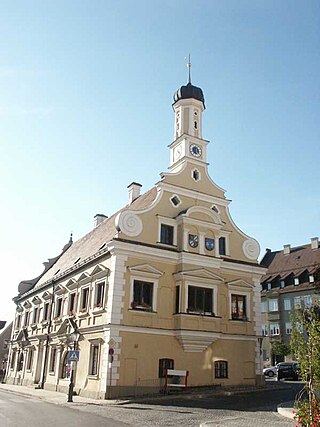
Friedberg is a town in the district Aichach-Friedberg, Bavaria, Germany, with some 30,000 inhabitants. It is located next to Augsburg at the river Lech. The town was founded in the 13th century in order to collect a toll from people using the bridge across the Lech.
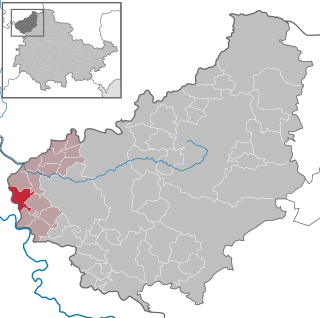
Bornhagen is a municipality in the district of Eichsfeld in Thuringia, Germany, located at the foot of the ruins of Hanstein Castle. The town district Rimbach is positioned directly south of the castle citadel at an elevation of 370 m. Bornhagen is located 22 km south of Göttingen, 85 km northwest of the state capital Erfurt and 270 km southwest of Berlin. It is the westernmost settlement in Thuringia but does not contain the westernmost point which is 75 km south near Geisa.

Donauwörth is a town and the capital of the Donau-Ries district in Swabia, Bavaria, Germany. It is said to have been founded by two fishermen where the rivers Danube (Donau) and Wörnitz meet. The city is part of the scenic route called "Romantische Straße".
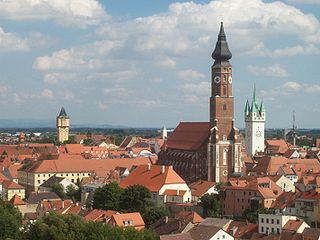
Straubing is an independent city in Lower Bavaria, southern Germany. It is seat of the district of Straubing-Bogen. Annually in August the Gäubodenvolksfest, the second largest fair in Bavaria, is held.

Deggendorf is a town in Bavaria, Germany, capital of the Deggendorf district.
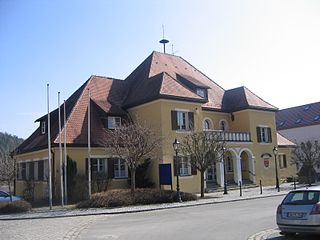
Stamsried is a village and municipality in the district of Cham in the Upper Palatinate region of Bavaria, Germany, near the Czech border. It is also located in the Roman Catholic diocese of Regensburg. Stamsried has a population of 2,319 as of June 2004 and an area of 4,343 hectares which includes surrounding countryside outside the built up area of the village itself, the population density is 53.4 persons per square kilometer. Stamsried is located 456 meters above sea level and contains rolling hills as high as 600 meters.

Neuburg an der Donau is a town which is the capital of the Neuburg-Schrobenhausen district in the state of Bavaria in Germany.

Roth is a town in Bavaria, Germany, the capital of the Roth District. It is located about 25 km south of Nuremberg.

Cham is the capital of the district of Cham in the Upper Palatinate in Bavaria in Germany.

Donaustauf is a market town in Bavaria, 5 km (3 mi) east of Regensburg at the foothills of the Bavarian Forest. The ruins of a medieval castle, presumably erected between 914 and 930, tower above the small town. Situated nearby on a hill rising from the Danube is the imposing Teutonic temple of fame, Walhalla, a costly reproduction of the Parthenon in Athens. The Walhalla was commissioned by Ludwig I, King of Bavaria, and inaugurated on 18 October 1842.

Rimbach is a municipality in the district of Cham (district) in the Upper Palatinate in Bavaria in Germany.

Rain is a town in the Donau-Ries district, in Bavaria, Germany. It is situated on the river Lech, close to its confluence with the Danube, 11 km east of Donauwörth.

Velburg is a town in the district of Neumarkt in Bavaria, Germany. It is situated 17 km southeast of Neumarkt in der Oberpfalz, and 39 km northwest of Regensburg.

Wallenfels is a town in the district of Kronach, in Bavaria, Germany. It is situated in the Franconian Forest, 11 km east of Kronach, and 32 km west of Hof.
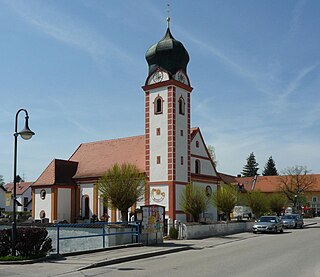
Langenbach is a municipality in the district of Freising in Bavaria in Germany.
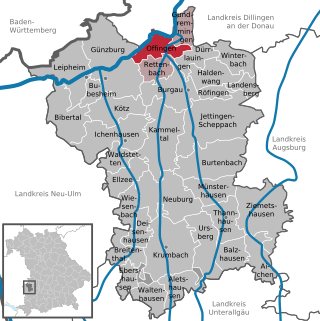
Offingen is a municipality in the Swabian administrative district Günzburg in Bavaria in Germany.

Neufahrn i. NB or Neufahrn in Niederbayern is a municipality in the district of Landshut in Bavaria in Germany. Its Bavarian name is Neifing.

Lupburg is a municipality in the district of Neumarkt in Bavaria in Germany.

The Gaststätte Röhrl is a restaurant with beer garden in Eilsbrunn in the district of Regensburg, Germany. Since 1658 it is continuously operated and owned by the Röhrl family.

























